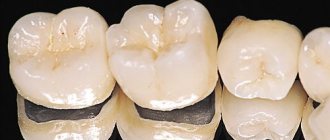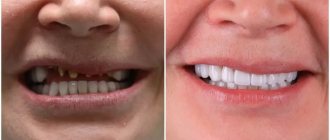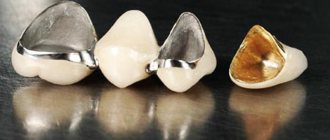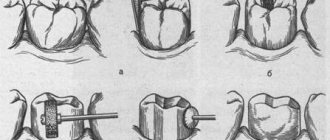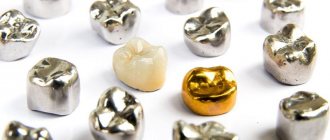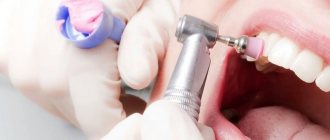Losing a molar leaves a gap in the row that needs to be filled. This can be done in two ways: install an artificial root with a crown or install a standard bridge, supported by adjacent units. Since there is a choice, the patient usually asks the dentist to explain which is better: an implant or a bridge for the chewing teeth. Objectively speaking, a durable crown on an artificial root is the best way to restore a lost unit. But in the case of molars and premolars, other options can be considered if implantation is for some reason impossible or not suitable.
Key Differences Between Dental Implants and Bridges
A prosthesis on an implant restores all the structural elements of a natural tooth – the root, neck and supragingival part (crown). The function of the root is performed by a screw rod, which is “implanted” into the bone tissue. A transitional element - an abutment - is fixed on it, and a crown of the color and shape of the removed unit is placed on top.
Pros of implants:
- The new tooth continues to put stress on the bone. Therefore, metabolic processes in it are preserved and atrophy slows down.
- The units adjacent to the defect remain intact.
- The gums around the restored tooth do not sag over time.
- With proper care, implants can last for decades.
A dental bridge is a series of three or four crowns welded together. The outermost ones look like hollow caps and are put on the supporting units. Medium ones - fill the gap in the row and rest on the gum.
Delete or leave?
The situation when a decision is made - to remove or preserve a wisdom tooth - requires a detailed consultation with a dentist. If the tooth can be saved, and the doctor offers a choice of a crown or filling, do not rush to save money (the crown will cost more). It is better to listen to the doctor’s advice and trust a competent specialist, weighing all the chances. It happens that a filling placed at risk to a tooth destroys it partially (and this will require a repeat procedure) or completely. In the latter case, nothing can be done.
It's a different matter when the wisdom tooth is badly neglected. For example, a patient came to the doctor with granulomas on the roots - removal according to the general rules is indicated here. Or the wisdom tooth initially erupts incorrectly (lays on its side, rests against the wall of another tooth, looks towards the cheek) - and in this case, removal is inevitable. Also, a wisdom tooth is removed if its appearance means a decrease in space for the growth of other teeth - with a short jaw arch.
Remember, the decision to preserve or remove a tooth is made only on the basis of an x-ray, which will clearly show how normal or pathological the tooth is. If the doctor advises you to get rid of your wisdom tooth immediately after a visual examination, change the clinic or doctor.
Install crowns on your wisdom teeth at Dr. Lopayeva’s clinic.
Make an appointment
Or call +7(985)532-21-01
Do they put crowns on wisdom teeth?
Installation of a metal-ceramic crown on the front teeth in Moscow
Treatment of a tooth under a crown without removal
How much do zirconium dioxide crowns cost for front teeth in Moscow?
Metal-ceramic crown or zirconium
Disadvantages of methods
When choosing what to install, a bridge or an implant on a chewing tooth, you also need to take into account the disadvantages of the methods. For example, installing an artificial root is a traumatic procedure. Treatment periods reach three to six months; prices are high, since in addition to the prosthesis, you need to pay for the installation of an implant.
The disadvantages of bridge prosthetics include the lack of load on the bone, the need to grind and remove the pulp of adjacent teeth, and the risk of gum subsidence under the prosthesis. In addition, the service life of a dental bridge is relatively short, since teeth covered with crowns often have to be treated and even removed after several years. And then the patient bears the cost of making a new design or still spends money on implantation.
In view of the listed advantages and disadvantages, implants are recommended to be used to restore frontal and lateral teeth. With chewable units, options can be considered.
Price
- Primary appointment (examination, consultation) with a dentist (special offer) 100001
For free
Promotion
- Drawing up a preliminary treatment plan without visiting 100020
For free
- Dental prosthetics using an SGS implant with a metal-ceramic crown (special offer) 300001
5 000 ₽
Promotion
- Dental prosthetics using an all-zirconium crown implant (special offer) 300002
10 000 ₽
Promotion
- Dental prosthetics using an implant All-zirconium crown with ceramic lining (special offer) 300003
19 900 ₽
Promotion
- Prosthetics of all jaw teeth on 4 implants
149 900 ₽
Promotion
A dental bridge on implants is an orthopedic design for restoring several missing teeth in a row. It consists of a series of artificial crowns, fixed to implants installed in the jawbone. The advantages of bridge prosthetics on implants are reliability, durability and functionality. The prosthesis performs the tasks assigned to it for 10 years. With proper care and use it lasts a lifetime. The cost depends on the extent of the defect, the brand of implants, their number and the material of the crowns in the prosthesis.
Indications for installing a bridge on abutment teeth
In some cases, it makes sense to think about installing a bridge structure. For example, you may choose this method if the adjacent teeth are damaged by caries or chipped due to injury. In this case, it is advisable to treat them and cover them with crowns. Bridge prosthetics is also used when the patient lacks financial resources, due to which he cannot yet undergo implantation. Contraindications can also become an obstacle to the installation of artificial roots, many of which, however, are temporary.
Fixation of a bridge depending on the number of teeth
Artificial teeth not only perform a chewing function and are used in articulation. The prosthesis must correctly transfer the load to the titanium roots. The service life of the implants and the orthopedic structure itself depends on this. Correct distribution of the load stops the atrophy of the alveolar ridge, eliminates gum subsidence, which helps maintain the aesthetics of the row. To fix the bridge, 2 implants are enough, but doctors recommend installing pins in a ratio of at least 1:2, that is, one titanium rod for 2 artificial crowns.
2 teeth
If 2 units are missing, it is recommended to restore each lost tooth. The patient receives 2 implants, each with a separate crown. The method provides aesthetics and neutralizes the consequences of the loss of natural teeth.
3 teeth
If a defect in a row is 3 units long, a single restoration can be performed. The second option for the patient is to install 2 implants on either side of the defect and replace the lost teeth with a bridge. A bridge on 2 implants for 3 teeth is fixed with cement or transocclusal fixation. The marginal crowns are firmly attached to the pins, while the central one remains suspended.
4 teeth
In the absence of 4 units, it is advisable to install 3 titanium roots. Fixing a bridge on two implants is possible, but the aesthetics and functionality of the structure will suffer. Without load, the area under two hinged crowns quickly sags as a result of atrophic processes. The risk of prosthesis breakage increases with increasing load on its central part.
5 or more
Prosthetics with a dental bridge supported by implants is also possible with significant row defects. If 5 units are missing, the patient is recommended to have at least 3 implants installed. With the correct calculation of the location of artificial roots, this amount is sufficient to evenly distribute the load. More extensive defects are eliminated with the number of titanium roots equal to half the number of crowns in the bridge.
Full bridges for the lower and upper jaw
Almost all edentulous patients can have dental bridges installed. The length of the structure is 12-14 crowns. Installation on implants ensures reliable fixation of the prosthesis and prevents it from falling out during talking or chewing.
The number of titanium roots is calculated individually for each patient. The choice depends on the reconstruction area and the patient's jaw anatomy.
- The mandibular bone is denser. To fix the bridge, 6 implants are required. A patient with a massive jaw may require 8 artificial supports to properly distribute the load.
- The bone of the upper jaw is less voluminous and looser, and is less subject to stress. To securely and stablely attach the bridge, at least 8 titanium rods will be required.
If the aesthetics of a smile is extremely important to a patient, even with complete edentia, you can count on implants with teeth outside the bridge. The classic implantation protocol involves installing 14 artificial roots on one jaw and fixing a separate crown on each of them. The disadvantage of the classic protocol is the price.
Wisdom teeth. Implantation? Treatment? Removal!
True, the question arises: with such advances in dentistry, why not take up the advanced practice of prosthetics for wisdom teeth? Why, despite the obvious success of implants, do dentists not offer this technology, but still simply remove them?
In order to answer these questions, it is first useful to understand what a “wisdom tooth” is.
What is a wisdom tooth
“Wisdom tooth” is the name given to the third molar, or in dentists’ terminology, a molar; such teeth are the last, both in position on the jaw and in the time of eruption. It generally occurs in the late teens or early 20s. Often wisdom teeth are called “eights”, according to the numbering accepted by dentists.
It should be recognized that these teeth are an inheritance inherited from our distant ancestors; modern people practically do not need them; in 25% they do not erupt at all, and people do not suffer from this. This situation is due to human evolution.
In nature, everything is purposeful and arranged very intelligently. The jaws can be thought of as a mechanical structure designed to grind and crush food. It is a kind of scissors or pliers, and the teeth provide the strong cutting edge of the tool. The closer the tooth is to the axis, or jaw joint, the greater the force, according to the rule of leverage, it creates when the jaws are compressed. The last molars were intended for chewing the hardest objects in our distant past. As an example, a dog chewing on a large, hard bone uses the very last molars and creates very powerful pressure with them.
People have been eating differently than their primitive ancestors for thousands of years; culinary processing has made our diet soft; effort is no longer needed. As a result, our wisdom teeth have long ago lost their significance, atrophied, and develop under completely different conditions than originally. They have become weak and fragile due to a lack of calcium and the uselessness of their functions, therefore they are most susceptible to caries, chipping, etc. In addition, the jaw of modern humans has become 4 mm shorter over the last two thousand years alone; there is simply no room left for “eights” on it.
This situation has led to problems specific to wisdom teeth.
Problems associated with wisdom teeth.
There are many problems with wisdom teeth, all of them, one way or another, lead to a decision in favor of removal rather than treatment, and affect the situation with the installation of implants. Let's start with late cutting. The wisdom tooth does not have a predecessor in the form of a milk tooth, and the process is more complex and painful. A focus of infection forms in the oral cavity, which is fraught with various inflammations and complications. Its position may deviate greatly from normal - dystopia (see pictures). With dystopia, its growth often leads to the destruction of the adjacent tooth. In some cases, growing wisdom teeth cause compression of the entire row, which contributes to the appearance of crooked teeth. From the point of view of consequences, an unerupted tooth is a time bomb that does not know when it will go off.
A normally erupted wisdom tooth that has not crushed or twisted its neighbors continues to be a source of trouble. This is again caused by the specifics of its position, and the special conditions of the place where it is located.
Wisdom teeth are difficult to reach, brushing is difficult, and they are also not cleaned naturally, since they are practically not used. Not being parallel to the neighbors creates deep cracks that are simply impossible to clean. A kind of stagnation zone is formed around them, with very favorable conditions for the development of bacteria. The result is frequent caries and again a persistent source of infection.
Treat or remove?
Treatment of wisdom teeth is extremely difficult. The reasons are the same - inaccessibility, incorrect position, incomplete view, difficulty in using a drill, plus - the canals and roots of the tooth are located unpredictably, it is very difficult to treat them. But that’s not the point; a highly qualified dentist can overcome all difficulties, even if it requires more time and skill. But what will this give?
The doctor will cope with the consequences, but he will not change the situation around the tooth and its position. The circumstances that led to the disease will continue to work, which means that soon everything will happen again. The real way to change the position is to remove your wisdom teeth.
Note that we were talking about the safest option, in cases where destruction of adjacent teeth occurs, removal is inevitable, and this must be done as quickly as possible.
In many cases, the mandatory removal of wisdom teeth has not been controversial for a long time. For example, it is beyond doubt and has become common practice to remove wisdom teeth before using braces to correct malocclusion, crookedness, etc. Without this, it is impossible to provide space for teeth to shift, remove the causes of twisting and record the result. Removal is also indicated in the treatment of trigeminal neuritis.
As an example, we can cite the practice of German dentists; in Germany, everyone’s wisdom teeth are removed as soon as they erupt.
As a result, we can say the following: wisdom teeth are a source of constant trouble; complete hygiene in the area where they are located cannot be reliably ensured, which means there will be caries and inflammatory processes. Their treatment is difficult and ineffective, the results are short-lived, which means it is better to remove them. This is the best way to avoid the risks of diseases and complications.
Why there is no point in installing an implant.
Theoretically, nothing prevents you from placing an implant; of course, the location and limited visibility make the work very difficult, but this is not the main thing. There are other reasons.
First. It is very difficult to determine the angle of installation of the rod, then implement everything with the required accuracy in a very hard-to-reach place. The last two pictures show what happens with a normal installation and a slight deviation.
In the second case, when the jaws are compressed, the load will not coincide with the axis of the implant, resulting in a lateral displacement force Ft. Do not forget that the load on the outer teeth is maximum. The force Ft will periodically loosen the rod, a gap will appear, microbes and food debris will get into it, what will be known later.
A regular molar can easily withstand lateral forces because it has multiple roots and is not rigidly attached to the bone. A kind of “bag” allows it to absorb shock, which will not happen with an implant.
Second. With an ideal installation, there will still be a joint between the crown and the gum, and it will not be cleaned, sooner or later it will become inflamed and this will lead to serious problems.
Third. This point is the most interesting, it sounds short - why is all this needed?!
Indeed, is it worth spending decent money in order to get the risk of complications and nothing more? Wisdom teeth are something like an appendix, they don't play an important role in chewing food, they don't affect your appearance, people feel great without them. Therefore, you should not waste time and money on useless treatment; it is better to take care of your health and remove them.
When is a crown placed on a living tooth?
The quality of endodontic treatment, which is carried out before dental prosthetics, largely depends on the presence or absence of pulp. In most cases, it is depulpation that allows all manipulations to be carried out more thoroughly, which significantly reduces the risk of any complications.
Treatment and installation of a crown on a living tooth requires local anesthesia. This method is performed extremely rarely, and the decision is made on an individual basis. This takes into account the level of tooth decay and the material used to make the crown. It is recommended to install only a zirconium crown or half-crown (like a veneer) on a living chewing tooth.

